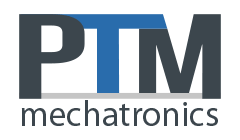FAQ
Sometimes it’s a relief when you don’t have to call or write because of short questions. That’s why we’ve collected the most frequently asked questions for you and will give you the answers right here.
If you can’t find what you’re looking for or would like to know more, just use the tried and tested methods and write to us or call us. You can find direct contact with us here.
General questions
Where can I find technical data, dimensions and certificates?
Data sheets, operating instructions and certificates can be found in the download area at the end of the respective product page for your motor model.
Where can I find CAD files for the motors?
CAD files can be found for the respective motor model in the download area further down on the product pages.
The download folder contains the individual assemblies and PDF instructions that show you how to configure the motor.
How do I choose the right motor size and transmission?
To configure the motor, the torque required in the application must first be determined. We specify the starting torque for our motors. By this we mean the torque that the motor develops when it starts. This is where the torque is highest. As the speed increases, the torque decreases slightly.
This means that the second factor that needs to be determined is the speed or speed range required for the application. Please refer to the performance data here for the torque and speed ranges of our motors.
There are also three transmissions to choose from that influence the torque and speed:
A 3:1 transmission triples the motors’s torque; At the same time, the speed range is only 1/3 of the motor without transmission.
A 9:1 transmission increases the motors’s torque nine times; At the same time, the speed range is only 1/9 of the motor without transmission.
A 1:2 transmission doubles the speed range to 600 instead of 300 rpm; the torque is halved at the same time.
At very low speeds, it is advantageous to use a 3:1 or 9:1 transmission, as this means that the rotational movement is more even than without a transmission. A standard motor only runs smoothly from around 30 rpm. With a 3:1 transmission the motor runs smoothly from around 10 rpm and with a 9:1 transmission from around 3 rpm.
To illustrate the considerations to be made, here are two practical examples:
Example 1:
I need a speed of 400 1/min with a torque of 2Nm.
A 1:2 transmission is necessary to achieve 400 rpm. In order to achieve 2Nm at 400 rpm, the 0900 motor will be necessary. The 0900 motor with a 1:2 transmission has a speed range of 0-600 rpm and a starting torque of 4Nm. At 400 rpm the motor delivers the desired 2Nm.
Example 2:
I need a speed of 20 1/min with a torque of 12Nm.
A 3:1 transmission is necessary to achieve the 20 1/min evenly and smoothly. In order to achieve 12Nm at 20 1/min, the 0450 motor will be necessary. The 0450 motor with a 3:1 transmission has a speed range of 0-100 rpm and a starting torque of 12Nm. At 20 rpm the motor delivers the desired 12Nm.
Does the motor suit my application?
Our motors are non-electric, incomplete machines within the meaning of the Mechanical Engineering Directive and are used as drives in machines and systems to drive wheels, rollers, brushes, agitators, conveyor belts and screws, etc. Furthermore, slides and valves as well as roller shutters etc. can be driven with it.
We would be happy to advise you in detail and discuss your application. You can find direct contact with us here.
Are there different sealing concepts?
All of our seals are silicone-free. We offer four different seals:
NBR – is our standard
Viton – for high temperature and chemical resistance
PTFE – solvent-resistant for long-term use
FDA compliant – made of white PTFE with FDA approval for hygienic use in food and pharma
Which compressed air is needed?
The medium used is prepared, non-oiled compressed air with 2-6 bar and a quality class of 5
according to ISO 8573-1 filtering level <=5μ used.
Can I also operate the motors with other media?
The use of liquids and gases is not part of the intended use of our engines. We would be happy to check your application accordingly. If possible, we can approve our motors to use certain gases.
Can a drive hub on the compressed air motor be replaced later?
Yes that works. Watch our how-to video on YouTube. Just click here.
Can I operate the motor underwater?
Yes, we have the IP68 model for this, which is completely waterproof. Product details for the IP68 motor can be found here.
Can I operate the motor outside or in a humid environment?
Yes, we have the IP68 model for this, which is completely waterproof. Product details for the IP68 motor can be found here.
Can I operate the motor in an explosive atmosphere?
Yes, we offer the ATEX model for this. You can operate our ATEX motors in ATEX zones 1, 2, 21 and 22. Product details can be found here.
Ex II 2 G Ex h IIC T5 Gb
Ex II 2 D Ex h IIIC T100°C Db X
The engines are not an ignition source for all gases, vapors and mists with an ignition temperature > 100°C. In dust hazardous areas, 100°C is the reference temperature for further considerations regarding the safety distance from the glow temperature.
What does the “X” at the end of the ATEX marking mean?
The manufacturer uses the “X” to indicate special conditions that are further explained in the operating instructions.
Our operating instructions state:
- The radial piston motor may be used in the ambient temperature range between -10°C to 80°C.
- The operator must ensure that only compressed air with a filtering level of < 5umm is used.
- The outer bearings must be replaced after a service life of 45,000 hours.
Can I operate the motor in a clean room?
Yes, we offer the INOX model for this. The stainless steel motors of the INOX series have a clean room classification ISO 1 according to DIN 14644. Product details can be found here.
Can I sterilize the motor?
Yes, we offer the INOX model for this. The stainless steel motors of the INOX series have a clean room classification ISO 1 according to DIN 14644. Product details can be found here.
What ambient temperature are the motors designed for?
The temperature range is -10°C to +80°C in the non-ATEX area and -10°C
up to +70°C in the ATEX area. In special cases we will give you approval up to 100°C. Please contact us so that we can discuss your application. You can find direct contact with us here.
Technical questions
How do I connect the compressed air to the motor?
For the models 0450 and 0900, two push-in fittings for 6mm hoses are included in the scope of delivery.
There are two G1/8 threads on the 1800 and 3600 models. Here you can, for example, connect push-in fittings for 8mm hoses.
A 90° connection is available for all models so that the air supply can be connected cleanly from the side. You can find the data sheet for this here.
How can the motors be attached?
There are four threads on the front and a small fitting flange for fastening. This means that the motor is placed centrally and mounted on a housing from the front. There is also a keyway on the fitting flange to mount the motor so that it cannot rotate. Please refer to the data sheet here for dimensions.
We also offer an optional mounting flange with four through holes. This allows the motor to be attached to a housing from behind. Product details can be found here. If your connection has to absorb higher radial forces, we recommend using the bearing flange. Product details can be found here.
To mount the motor on a floor plate, for example, there is an optional mounting angle. This allows you to attach the motor from above with four screws. Product details can be found here.
How can I adjust the speed?
The speed is determined by the amount of air. The speed can therefore best be adjusted using a throttle. The pressure should always be 6 bar so that the torque is maintained.
The speed can also be adjusted via the air pressure. If the pressure is reduced using a pressure gauge, the speed decreases, but so does the torque.
You can find a circuit diagram for the motor here.
How can I adjust the torque?
The torque is determined by the air pressure. The highest torque is at 6 bar. If the pressure is reduced using a pressure gauge, there is less torque. At the same time, the speed also drops and the air volume may have to be increased via the throttle.
You can find a circuit diagram for the motor here.
At what speed can I operate the motors?
Our motors can be used between 0 and 300 rpm and at a maximum of 6 bar. Technical measures that enable faster speeds can destroy the motor.
Which drive hubs are available for the motor?
Different drive hubs are available for the motor, e.g. 14, 19, 24 and 32mm. The exact dimensions for your model can be found in the respective data sheet, which you can find in the download area on the respective product page.
It is also possible for us to create a customized special hub for you. All we need from you is a small sketch. We take care of creating a production drawing. Please contact us here.
Can the motors be used as brakes?
Our motors cannot be used as a brake or to absorb high loads.
Can I permanently load the motor in one direction of rotation?
If you permanently load the motor in one direction of rotation (e.g. to drive a conveyor belt, an agitator or a cleaning brush), we recommend using our drive “eco”, which is equipped with a connection block as standard. This ensures long mileage in one direction of rotation. You can find product details about the drive “eco” here.
Is the air motor reversible and how can the direction of rotation be adjusted?
Yes, the motor can be reversibly controlled in both directions of rotation. Important here: In order to switch from one direction of rotation to the other, the motor must first come to a complete standstill. Changing it during operation will cause damage to the motor.
You can find a circuit diagram for the motor here.
Can the motors hold their position?
Our motors have no brakes. This means they cannot hold the position on their own.
Are there any wearing parts on the motor?
Our motors are extremely robust and low-maintenance. There are only two components that require maintenance under certain circumstances:
Pistons
Depending on the application and operating hours, it may be necessary to change the pistons over the years. If, for example, the motor in a manipulator is regularly briefly controlled in both directions in two-shift operation, a 10-year maintenance-free mileage can be expected. The same applies if the motor is used, for example, to open and close gates, sliders and valves. However, if the motor runs in one direction of rotation all year round, for example with a cleaning brush, it may be necessary to change the pistons of the motor after two years as they wear out. A low speed of the cleaning brush will extend the life of the pistons by another two years.
We generally recommend using our optional connection block. This can extend the life of your motor. Product details can be found here.
Motor wear is indicated by a drop in performance or an increase in noise. We would be happy to advise you on creating a suitable maintenance cycle specifically for your application. We will then be happy to change the pistons for you. Please contact us for this. You can find direct contact with us here.
You can also easily change the pistons yourself. All you need is our piston service kit, which you can order from us. You can find out more about changing pistons in our how-to video here.
Shaft seal
The shaft seal on the drive hub can also wear out. The motor’s performance is therefore not affected. When used in a humid environment and with the IP68 and INOX models, it may be necessary to change the shaft seals regularly. Here, too, we would be happy to advise you on a sensible maintenance plan. We will also be happy to change the shaft seal for you. Please contact us here.
Can the motor absorb high radial and axial forces?
Our engines are to be seen as pure drives. They therefore cannot absorb high radial and axial forces. If this is necessary for your application, we offer an optional bearing flange that can absorb significantly higher forces via two additional ball bearings. Product details can be found here.
Questions about accessories
Can a PTM transmission be retrofitted to the compressed air motor?
In our motors, the motor and transmission are a compact assembly. A PTM transmission can only be installed on the motor by our service department. To do this, you must send the motor to us. Please contact us before shipping to plan the process. You can find direct contact with us here.
Can the PTM transmission be subsequently replaced with a compressed air motor?
In our motors, the motor and transmission are a compact assembly. A PTM transmission can only be installed on the e motor by our service department. To do this, you must send the motor to us. Please contact us before shipping to plan the process. You can find direct contact with us here.
Do you offer a suitable compressed air supply?
Can I record, control or display the speed?
For our motors there is a preparation for a speed sensor to record the speed for your own control. We also offer a speed display and speed control.
Troubleshooting
My motor is slowing down? What's up?
If your motor slows down, you don’t have to worry at first. The loss of power is likely due to natural wear on the pistons. Feel free to contact us. We will then decide together whether you send your PTM product in for maintenance, we send you a maintenance package or an exchange needs to take place.
My motor is getting louder? What's up?
If your motor gets louder, you don’t have to worry at first. The increase in noise is likely due to natural wear on the pistons. Feel free to contact us. We will then decide together whether you send your PTM product in for maintenance, we send you a maintenance package or an exchange needs to take place.
Questions about the company
What are the core areas of PTM mechatronics?
Die PTM mechatronics ist auf die zwei Kernbereiche Antriebstechnik und Rührwerkstechnik spezialisiert. Für beide Sparten verfügen wir über ein systematisches Projektmanagement zur Umsetzung maßgeschneiderter Komplettanlagen. Spezialthemen, für die wir Expertenwissen mitbringen, sind Lebensmittelsicherheit und Einhaltung hoher Hygienestandards bis hin zu Reinraum, ATEX-Schutz und Arbeitssicherheit.
PTM mechatronics specializes in the two core areas of drive technology and stirring technology. We have systematic project management for the implementation of tailor-made complete systems for both divisions. Special topics for which we have expert knowledge include food safety and compliance with high hygiene standards through to clean rooms, ATEX protection and occupational safety.
Can I implement complex projects with PTM mechatronics?
We have decades of experience in implementing large-scale, tailor-made projects. We supplement our drive and stirring technology with upstream and downstream components in order to be able to offer you everything you need in your system and for your application from a single source. We construct the entire structure in one piece. Please also visit our “Plant construction” product page.
Is PTM mechatronics certified? Where can I find the certificates?
PTM mechatronics is both ISO and ATEX certified. We update these certifications regularly at the prescribed intervals. You can find the relevant documentation on our company website here.
Questions about contact
How do I reach a contact person as quickly as possible?
The quickest way to reach us during the day is by telephone on +49 8134 25 797 0. If you would like to communicate your concerns quickly but prefer to do so in writing, simply use our chat function on the bottom left of your screen. The chat function is available to you every day during normal business hours.
And of course you can write us an email to info@ptm-mechatronics.com.
I would rather chat instead of making a phone call. Is that possible?
You can find our chat function on the bottom left of your screen. The chat function is available to you every day during normal business hours.
Please contact us:
If you would like to be advised on our products, our experts will gladly take care of your request:



